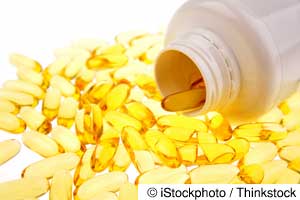Taking omega-3 fatty acids and vitamin D3 supplements did not increase nor decrease the risk for incident atrial fibrillation over 5 years, according to results of the VITAL Rhythm trial.

Christine M. Albert
“Our findings do not support the use of either [eicosapentaenoic acid/docosahexaenoic acid] or vitamin D3 for primary prevention of incident AF,” Christine M. Albert, MD, MPH, president of the Heart Rhythm Society and founding chair of the department of cardiology in the Smidt Heart Institute at Cedars-Sinai Medical Center in Los Angeles, said during a press conference. The results “also don’t show any increased risk in AF for patients who are using these supplements for other indications.”

VITAL Rhythm is an ancillary study of VITAL, a primary prevention trial of CVD and cancer conducted in more than 25,000 U.S. adults. The trial evaluated whether daily supplementation with 2,000 IU of vitamin D3 and/or 840 mg of omega-3 fatty acids (Omacor, Pronova BioPharma/BASF; 1 g per day), composed of 460 mg eicosapentaenoic acid (EPA) and 380 mg docosahexaenoic acid (DHA), would reduce risk for incident AF compared with placebo.
No reduction, increase in AF
During a median treatment duration of 5.3 years, 900 participants — 3.6% of the population — had a confirmed AF event. AF events were determined by participants self-reports and CMS claims data, and events were then confirmed by medical record review, Albert said. Seventy-three percent of the AF events observed during follow-up were confirmed by ECG and 27% by medical record reports.
Most events were paroxysmal AF (58.4%) and 62% of patients had symptoms present at diagnosis, but a “good fraction” of participants had no symptoms before their diagnosis, Albert said.
The trial had 92% power to detect a 20% reduction or increase in the observed HR for incident AF. The incidence of AF in the omega-3 fatty acid group, compared with the placebo arm, was slightly greater, but not significantly so (HR = 1.09; 95% CI, 0.96-1.24; P = .19), Albert said. Similarly, the vitamin D group did not show a reduction or an increase in the incidence of AF compared with placebo (HR = 1.09; 95% CI, 0.96-1.25; P = .19).
VITAL Rhythm was a randomized, double-blind, placebo-controlled trial with a 2×2 factorial design. Researchers enrolled 25,119 participants who had no prior history of CVD cancer or AF at baseline. The mean age was 67 years, 51% were women and 20% were Black.
‘Roadmap’ for AF primary prevention trials
“The use of dietary supplements, including fish oil and vitamin D, is popular in the community. The health benefits, however, have not been proven in CVD,” Renate B. Schnabel, MD, MSc, interventional cardiologist, professor in cardiology at University Heart Center Hamburg, Germany, said during a press conference discussion of the VITAL Rhythm results. (See Healio’s previous coverage of the main VITAL trial here.)
There is a lack of randomized controlled trials in AF primary prevention, largely due to concerns of feasibility, according to Albert. Low levels of marine omega-3 fatty acids and vitamin D have been associated with increased risk for incident AF, but large-scale and long-term randomized data, to date, were lacking, she said.
VITAL Rhythm is the “first large-scale, long-term, randomized, placebo-controlled trial to prospectively test the effect of any intervention on incident AF,” Albert said.
“Future research testing other strategies to prevent AF is needed. There are several other strategies that involve lifestyle, weight reduction, blood pressure reduction,” she said. “I hope that this trial can provide a roadmap for how these primary prevention AF trials can be performed.”
VITAL Rhythm “has set the stage for primary prevention trials in AF,” Schnabel said. “In the future, AF detection will be enhanced by wearables and other devices, but it definitely shows us the increasing relevance of more pragmatic trials that are plausible and may provide valid results.”
PERSPECTIVE
Annabelle Santos Volgman, MD, FACC, FAHA
This was one of several AF trials presented at AHA which showed that preventing AF is harder than just giving fish oils and vitamin D. These trials give us more clarity in how to prevent, treat and detect AF in patients at high risk for strokes and major adverse CV events.
The VITAL Rhythm trial is an ancillary trial of the VITAL trial, a primary prevention trial of CVD and cancer of 25,871 American men and women. The study examined whether daily supplementation with 2,000 IU of vitamin D3 and/or 840 mg of omega-3 fatty acids (Omacor 1 g per day), comprised of 460 mg EPA and 380 mg of DHA, would prevent AF. After a follow-up period of 5.3 years, neither reduced nor increased the incidence of AF. To prevent AF we recommend patients control risk factors such as hypertension, obesity and sleep apnea, and avoid or limit alcohol.
Annabelle Santos Volgman, MD, FACC, FAHA
Cardiology Today Editorial Board Member
Rush University School of Medicine
Governor-elect, American College of Cardiology of Illinois
Chair, American Heart Association Women in Cardiology















What Causes Cachexia?
Numerous Other Studies Show the Positive Effects of Omega-3s on Cachexia
Krill Oil—NOT Fish Oil—Is Your Best Source of Omega-3 Fatty Acids
Other Important Nutritional Aspects, for Those Who Have Cancer